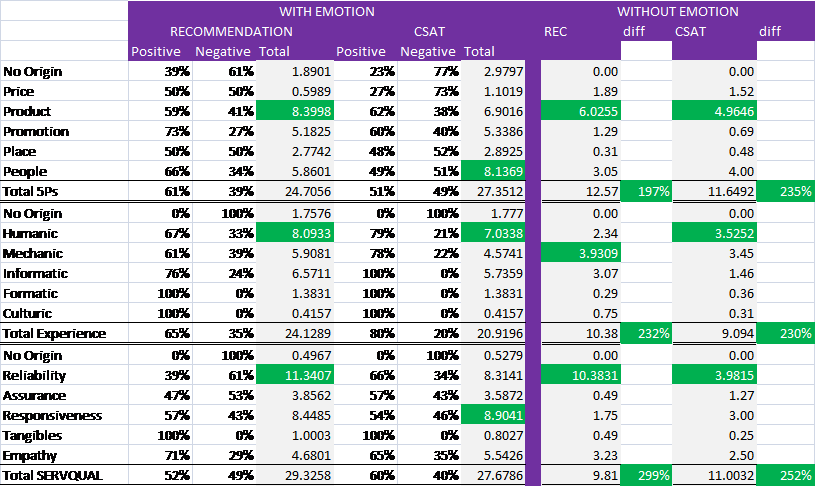
What really drives value in customer experience
Beyond Philosophy has used a subset (n=10,000 over 18 experiences) of our world leading database of emotion interviews (n=30.000) to quantify both the effects of emotion on value and which touchpoints are emotional drivers.
To ensure an ‘apples for apples’ comparison we created 3 models, one based on a traditional Marketing approach, one based on a Customer Experience Journey based approach and one based on SERVQUAL (an academic model of Service Quality). This required recoding these 1,000+ touchpoints into the Marketing-Experience and Service Quality categories separately.
What we found is as follows:
Figure 1: With and Without Emotion Comparisons of Value Using SEM Based Predictive Modelling (n=10,000 over 18 cross industry samples)
In this figure we can see several surprising features:
Overall Effects of Emotion
- Over all models positive emotions drive more value than negative emotions: this challenges the usual business view that avoiding negative emotions should be the focus for an intervention
- With emotion models drive more value than models without emotion: in all cases this is quite substantial, models without emotion leave value on the table. The difference is shown in the column diff with value driven with emotion of between 197% and 299% over models without emotion. A baseline statement would be ‘twice the value can be extracted from an experience when you include emotion’. Even when the driver origins are the same, thinking about emotional engagement can in many cases double the value extracted.
- Customer Journey models are most affected by positive emotions: this is in line with current understanding of the emotional effect of customer clues in the journey.
- Without emotion models would misallocate resources: for instance, in Marketing models, the driver value on CSAT is assumed to be product when in fact with emotion it is people (and more powerfully so); in Experience models the driver value on NPS® is Humanic with emotion yet Mechanic without.
- Emotion – again the emotional effect of the humanic is substantially higher. Finally, on SERVQUAL while NPS® is similar in effect on Reliability, on CSAT Reliability is assumed to drive value whereas it is Responsiveness that actually drives substantially more value when emotion is taken into account.
- A small amount of emotional value is unaccounted for: not all touchpoints account for emotional effects. This is unsurprising as emotions are ill-considered by most firms so experience is unoptimised.
Marketing Model (5Ps)
This uses the traditional Marketing view of Price, Product, Promotion, Place and People
- Price lacks an emotional effect: this is quantifiable evidence for the standard view that price is a transactional differentiator, it fails to emotionally engage.
- Product is the main driver of emotion with Recommendation (NPS® question): this is evidence for companies to avoid believing their own hype as to what is emotional or not. There is plenty of emotional energy in the product. It is unsurprising this outweighs the people side as marketing models are focused on point of sale rather than the customer journey. Nonetheless, people are of second importance and should not be forgotten.
- People is the main driver of emotion with CSAT: this is an interesting finding. The expectancy was that CSAT drivers of emotion would not differ from NPS® but this is not the case from a Marketing angle. One interpretation is that CSAT is a fairly transactional measure and leaves more emotional value on the table than NPS® – which is shown across all models. Hence, when there is an emotional effect it is marginally more powerful. In this paradigm, product effects are likely to be marginally more taken for granted whereas people effects are more emotionally surprising.
Experience Models
This uses the Customer Journey Factors as outlined in our book ‘Future trends and insights’ (Shaw, Dibeehi, Walden) i.e., Humanic (people), Mechanic (process), Informatic (information giving), Formatic (form), Culturic (culture).
- The Human factor (humanic) drives most emotion in the experience: this is quantifiable evidence that when we look at the Customer Journey the human factor drives most emotional value whether your measure is CSAT or NPS®.
- Informatic effects are important emotion drivers: interestingly information giving is more important to emotional value than process.
SERVQUAL Models
This uses the traditional approach to looking at Service Quality.
- Reliability effects are adequately accounted for over NPS® with or without emotion.
- Responsiveness effects are underestimated in the CSAT models: on CSAT, SERVQUAL would allocate resources more towards reliability than the more powerful emotional value effects of responsiveness.
Management Implications
- In quantifying where to invest for best returns, companies must take into consideration the substantial effects of emotion on the value of an experience that can be extracted and which touchpoints to invest in or cut.
- Companies must not resort to folklore in their assessment of emotional response. They must use an established approach and measure of emotion.
- Companies must use Experience based touchpoints as well as Marketing and SERVQUAL to get a rounded impression of touchpoint value.
| Steven Walden is VP Consulting and Thought-Leadership for Beyond Philosophy. Steven has 17 years Strategy Consultancy experience directing and designing strategies for major B2C & B2B firms. At Beyond Philosophy, the Global Customer Experience Consultancy, he is a Thought Leader and Innovator, directing engagements to assist leading firms to transform through Customer Experience. A world-leader in emotional experience his skills lie in innovation, thought-leadership, strategy consultancy and Qual/ Quant research. He is a regular speaker at conferences, blog writer, CE Trainer and international author. |
| Qaalfa Dibeehi is Chief Operating and Consulting Officer at of Beyond Philosophy one of the world’s first organizations devoted to customer experience. Qaalfa is an international co-author of Customer Experience: Future Trends and Insights. Beyond Philosophy provide consulting, specialised research & training from offices in Atlanta, Georgia and London, England. |


